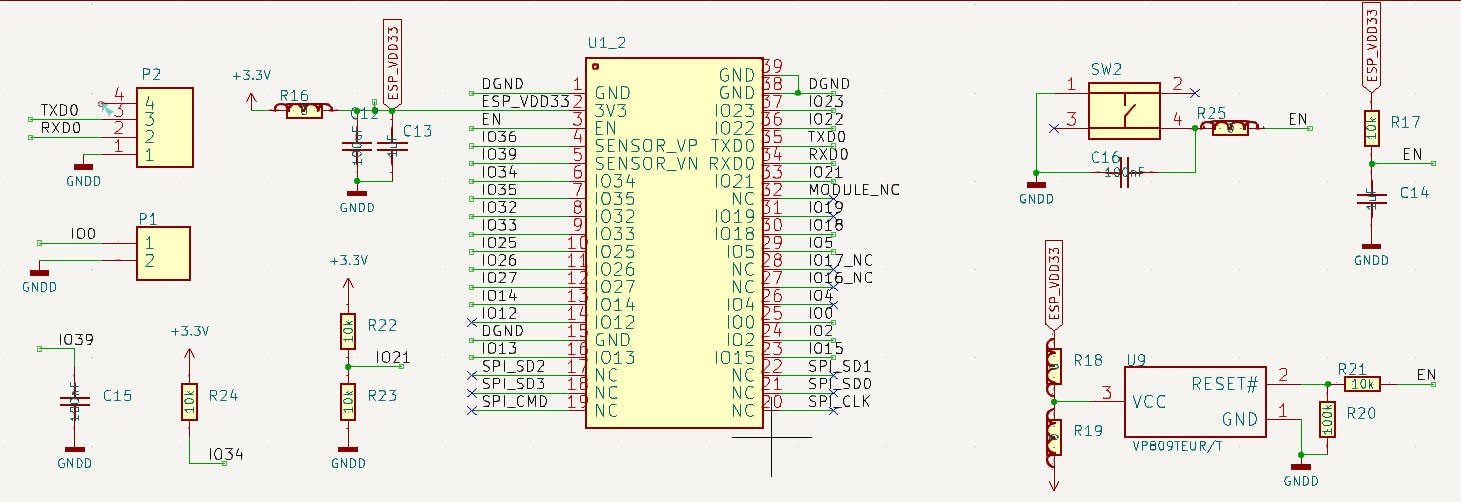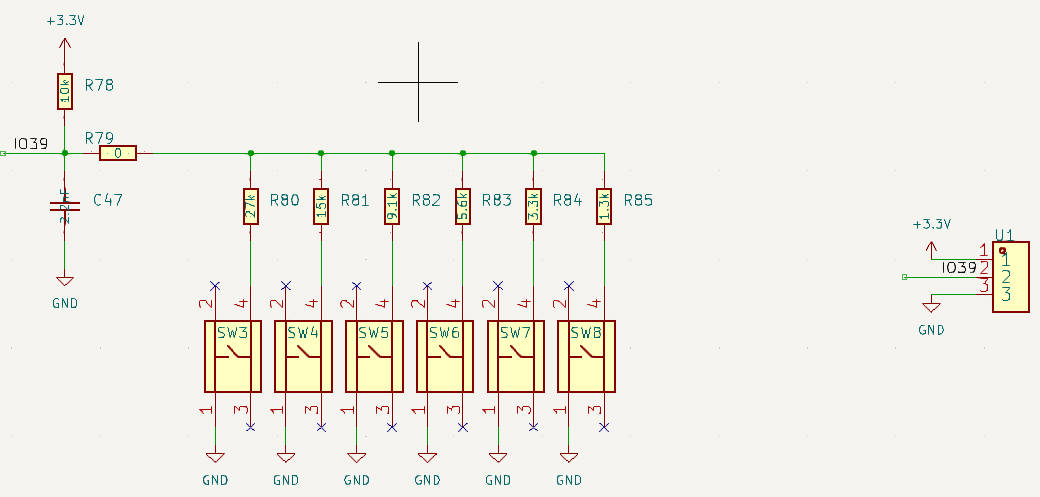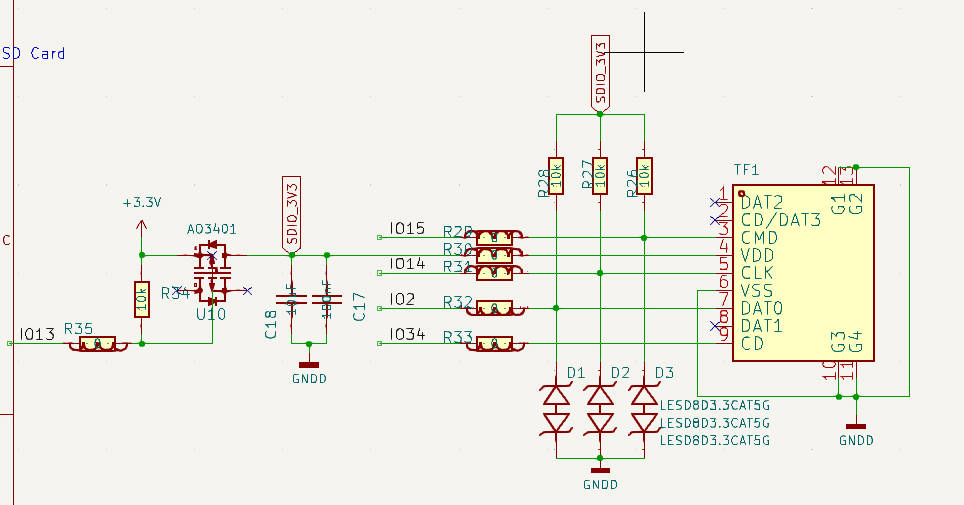项目介绍
该个人智能语音助理的需求源于对更加便捷、高效和智能的生活方式的追求。期望通过语音命令轻松管理日常任务、获取信息、控制家庭设备、进行语音搜索以及获得定制化建议,从而提升个人和家庭生活的体验。能够满足人们对更智能、互联和个性化服务的需求。
具体需求如下:
- 支持在线语音交互,能够查询天气、查找信息、答案问题等,以及播放音乐
- 支持离线使用,能够支持TF卡保存音频资源,并离线播放
- 内置锂电池,具有电池充放电管理,支持长时间待机。
市场应用介绍
个人智能语音助理在市场应用中提供了多样化的功能,包括日程管理、智能家居控制、媒体播放、在线购物、语言学习、社交媒体互动、健康追踪、旅行规划等。它们通过语音命令实现便捷操作,提高用户的生活质量,助力各个领域的个人和家庭生活更加智能和互联。
项目设计思路
该项目采用ESP32-WROVER-E作为主控,由于项目需求较复杂,故采用freertos系统进行编程,进而保证的系统运行的实时性。编程采用ESP-ADF进行编程。
项目方案框图和原理图解释
方案框图
框图的分享链接如下:https://www.digikey.cn/schemeit/project/story-teller-9d42eb69cb3d4171adabef9b0b8aaa3a
整个系统主要包括电源电路、SD卡电路、按键输入电路、音频输出电路和麦克风电路。
系统主要分为在线模式和离线模式。在线模式使用Smartconfig进行配网,语音交互采用语音唤醒和VAD,当用户话音结束后,将语音数据上传至百度云语音识别API,之后将识别到的文字传至百度文心一言平台,并获得相应的对话回复,之后使用自己搭建的tts服务器将对话回复文本转换为音频文件播放。在离线模式下,通过按键控制音频的播放暂停和上一首、下一首以及音量控制。
原理图
电源电路
在电源电路中,为了保证供电的稳定性,用两个稳压模块对ESP32和音频电路分别供电。
主控电路
主控芯片采用ESP32-WROVER-E,是一款通用型 Wi-Fi + Bluetooth + Bluetooth LE MCU 模组,功能强大,用途广泛,可以用于低功耗传感器网络和要求极高的任务,例如语音编码、音频流和 MP3 解码等。ESP32-WROVER-E-N8R8具有8M的SRAM和8M的Flash,能够满足语音识别所需要的运行资源。

按键电路
按键分别包括模式切换、播放\暂停、上一首、下一首、音量加、音量减,采用ADC按键,只需占用一个GPIO口,占用资源较小。

SD卡电路
SD卡采用单线驱动方式,节省GPIO口资源。

音频电路
使用ADC芯片ES7243E将麦克风采集到的信号传递给esp32。ES7243E是顺芯广泛推广的高性能先进多位Delta-sigma音频ADC芯片,具有高达 -90dB THD+N的失真度,24-bit,8~48 KHz的采样率,并且具有自动电平控制(ALC)和噪声门,极具高性价比优势。
音频放大部分采用NS4150B芯片。NS4150B是一款超低EMI、无需滤波器的3W单声道D类音频功率放大器。NS4150B采用先进的技术,在全带宽范围内极大地降低了 EMI 干扰,最大限度地减少对其他部件的影响。NS4150B 内置过流保护、过热保护及欠压保护功能,有效地保护芯片在异常工作状况下不被损坏。并且利用扩频技术充分优化全新电路设计,高达90%的效率更加适合于便携式音频产品。NS4150B 无需滤波器的 PWM 调制结构及增益内置方式减少了外部元件、PCB 面积和系统成本。
设计中用到规定厂商的元器件介绍
ESP32-WROVER-E 和 ESP32-WROVER-IE 是两款通用型 Wi-Fi + Bluetooth + Bluetooth LE MCU 模组,功能强 大,用途广泛,可以用于低功耗传感器网络和要求极高的任务,例如语音编码、音频流和MP3解码等。 ESP32-WROVER-E 采用 PCB 板载天线。该模组有多种版本,分别具有不同大小的Flash和Psram。本项目采用的是8M Flash和 8M Psram的模组。
ESP32-WROVER-E 和 ESP32-WROVER-IE 采用的芯片是 ESP32 系列的ESP32-D0WD-V3 或 ESP32-D0WDR2-V3*。ESP32-D0WD-V3 和 ESP32-D0WDR2-V3 芯片具有可扩展、自适应的特点。两个CPU 核可以被单独控制。CPU时钟频率的调节范围为80MHz到240MHz。用户可以关闭CPU的电源,利用低功 耗协处理器监测外设的状态变化或某些模拟量是否超出阈值。ESP32还集成了丰富的外设,包括电容式触摸传 感器、SD卡接口、以太网接口、高速SPI、UART、I2S和I2C等。
ESP32 的操作系统是带有LwIP的freeRTOS,还内置了带有硬件加速功能的TLS1.2。芯片同时支持OTA加密 升级,方便用户在产品发布之后继续升级。
参考文档:esp32-wrover-e_esp32-wrover-ie_datasheet_cn
PCB绘制打板介绍及遇到的问题和解决方法
- 在PCB设计的时候由于原理图检查不仔细,导致某条电源线没接到芯片上,最后使用飞线暂时解决,并在原理图和PCB上进行了修改。因此在检查原理图时应该仔细加仔细。
- 在购买芯片是没有注意,ES7243和ES7243E是两款不同的芯片,虽然ESP-ADF都支持,但是在编程的时候还是有区别的,从而导致了刚开始的时候以为是电路板绘制和焊接又有问题了,最后通过仔细对比原理图和代码找到了问题。
- 板子采用手工焊接,封装主要采用0805。但其中ES8311和ES7243为QFN封装,用烙铁焊接较为困难。并且这是我首次焊接QFN封装芯片(最开始开始尝试用电烙铁焊接,结果报废了两个板子),建议使用热风枪,我使用的是低温无铅焊锡和小型DIY热风枪。
关键代码及说明
smartconfig配网
static void smartconfig_task(void * parm)
{
EventBits_t uxBits;
ESP_ERROR_CHECK( esp_smartconfig_set_type(SC_TYPE_ESPTOUCH) );
smartconfig_start_config_t cfg = SMARTCONFIG_START_CONFIG_DEFAULT();
ESP_ERROR_CHECK( esp_smartconfig_start(&cfg) );
while (1) {
uxBits = xEventGroupWaitBits(s_wifi_event_group, CONNECTED_BIT | ESPTOUCH_DONE_BIT, true, false, portMAX_DELAY);
if(uxBits & CONNECTED_BIT) {
ESP_LOGI(TAG, "WiFi Connected to ap");
}
if(uxBits & ESPTOUCH_DONE_BIT) {
ESP_LOGI(TAG, "smartconfig over");
esp_smartconfig_stop();
vEventGroupDelete(s_wifi_event_group);
vTaskDelete(NULL);
}
}
}
static void wifi_event_handler(void* arg, esp_event_base_t event_base,
int32_t event_id, void* event_data)
{
if (event_base == WIFI_EVENT && event_id == WIFI_EVENT_STA_START) {
xTaskCreate(smartconfig_task, "smartconfig_task", 4096, NULL, 3, NULL);
} else if (event_base == WIFI_EVENT && event_id == WIFI_EVENT_STA_DISCONNECTED) {
esp_wifi_connect();
xEventGroupClearBits(s_wifi_event_group, CONNECTED_BIT);
} else if (event_base == IP_EVENT && event_id == IP_EVENT_STA_GOT_IP) {
xEventGroupSetBits(s_wifi_event_group, CONNECTED_BIT);
} else if (event_base == SC_EVENT && event_id == SC_EVENT_SCAN_DONE) {
ESP_LOGI(TAG, "Scan done");
} else if (event_base == SC_EVENT && event_id == SC_EVENT_FOUND_CHANNEL) {
ESP_LOGI(TAG, "Found channel");
} else if (event_base == SC_EVENT && event_id == SC_EVENT_GOT_SSID_PSWD) {
ESP_LOGI(TAG, "Got SSID and password");
smartconfig_event_got_ssid_pswd_t *evt = (smartconfig_event_got_ssid_pswd_t *)event_data;
wifi_config_t wifi_config;
bzero(&wifi_config, sizeof(wifi_config_t));
memcpy(wifi_config.sta.ssid, evt->ssid, sizeof(wifi_config.sta.ssid));
memcpy(wifi_config.sta.password, evt->password, sizeof(wifi_config.sta.password));
wifi_config.sta.bssid_set = evt->bssid_set;
if (wifi_config.sta.bssid_set == true) {
memcpy(wifi_config.sta.bssid, evt->bssid, sizeof(wifi_config.sta.bssid));
}
char ssid[33] = { 0 };
char password[65] = { 0 };
memcpy(ssid, (char *)evt->ssid, sizeof(evt->ssid));
memcpy(password, (char *)evt->password, sizeof(evt->password));
nvs_set_sta(ssid, password);
ESP_ERROR_CHECK( esp_wifi_disconnect() );
ESP_ERROR_CHECK( esp_wifi_set_config(WIFI_IF_STA, &wifi_config) );
esp_wifi_connect();
} else if (event_base == SC_EVENT && event_id == SC_EVENT_SEND_ACK_DONE) {
xEventGroupSetBits(s_wifi_event_group, ESPTOUCH_DONE_BIT);
}
}
void smartconfig_wifi(void)
{
s_wifi_event_group = xEventGroupCreate();
esp_wifi_stop();
esp_wifi_deinit();
wifi_init_config_t cfg = WIFI_INIT_CONFIG_DEFAULT();
ESP_ERROR_CHECK( esp_wifi_init(&cfg) );
ESP_ERROR_CHECK( esp_event_handler_register(WIFI_EVENT, ESP_EVENT_ANY_ID, &wifi_event_handler, NULL) );
ESP_ERROR_CHECK( esp_event_handler_register(IP_EVENT, IP_EVENT_STA_GOT_IP, &wifi_event_handler, NULL) );
ESP_ERROR_CHECK( esp_event_handler_register(SC_EVENT, ESP_EVENT_ANY_ID, &wifi_event_handler, NULL) );
ESP_ERROR_CHECK( esp_wifi_set_mode(WIFI_MODE_STA) );
ESP_ERROR_CHECK( esp_wifi_start() );
}
语音唤醒和VAD配置
static void start_recorder()
{
audio_element_handle_t i2s_stream_reader;
audio_pipeline_cfg_t pipeline_cfg = DEFAULT_AUDIO_PIPELINE_CONFIG();
pipeline_rec = audio_pipeline_init(&pipeline_cfg);
if (NULL == pipeline_rec) {
return;
}
i2s_stream_cfg_t i2s_cfg = I2S_STREAM_CFG_DEFAULT();
i2s_cfg.i2s_port = CODEC_ADC_I2S_PORT;
i2s_cfg.i2s_config.use_apll = 0;
i2s_cfg.i2s_config.sample_rate = CODEC_ADC_SAMPLE_RATE;
i2s_cfg.i2s_config.bits_per_sample = CODEC_ADC_BITS_PER_SAMPLE;
i2s_cfg.type = AUDIO_STREAM_READER;
i2s_stream_reader = i2s_stream_init(&i2s_cfg);
audio_element_handle_t filter = NULL;
#if CODEC_ADC_SAMPLE_RATE != (16000)
rsp_filter_cfg_t rsp_cfg = DEFAULT_RESAMPLE_FILTER_CONFIG();
rsp_cfg.src_rate = CODEC_ADC_SAMPLE_RATE;
rsp_cfg.dest_rate = 16000;
filter = rsp_filter_init(&rsp_cfg);
#endif
raw_stream_cfg_t raw_cfg = RAW_STREAM_CFG_DEFAULT();
raw_cfg.type = AUDIO_STREAM_READER;
raw_read = raw_stream_init(&raw_cfg);
audio_pipeline_register(pipeline_rec, i2s_stream_reader, "i2s");
audio_pipeline_register(pipeline_rec, raw_read, "raw");
if (filter) {
audio_pipeline_register(pipeline_rec, filter, "filter");
const char *link_tag[3] = {"i2s", "filter", "raw"};
audio_pipeline_link(pipeline_rec, &link_tag[0], 3);
} else {
const char *link_tag[2] = {"i2s", "raw"};
audio_pipeline_link(pipeline_rec, &link_tag[0], 2);
}
audio_pipeline_run(pipeline_rec);
ESP_LOGI(TAG, "Recorder has been created");
recorder_sr_cfg_t recorder_sr_cfg = DEFAULT_RECORDER_SR_CFG();
recorder_sr_cfg.afe_cfg.memory_alloc_mode = AFE_MEMORY_ALLOC_MORE_PSRAM;
recorder_sr_cfg.afe_cfg.wakenet_init = WAKENET_ENABLE;
// recorder_sr_cfg.feed_task_core=0;
// recorder_sr_cfg.fetch_task_core=0;
recorder_sr_cfg.multinet_init = false;
recorder_sr_cfg.afe_cfg.aec_init = RECORD_HARDWARE_AEC;
recorder_sr_cfg.afe_cfg.agc_mode = AFE_MN_PEAK_NO_AGC;
audio_rec_cfg_t cfg = AUDIO_RECORDER_DEFAULT_CFG();
cfg.read = (recorder_data_read_t)&input_cb_for_afe;
cfg.sr_handle = recorder_sr_create(&recorder_sr_cfg, &cfg.sr_iface);
cfg.event_cb = rec_engine_cb;
cfg.vad_off = 500;
recorder = audio_recorder_create(&cfg);
}在线tts服务器搭建
from flask import Flask, current_app, redirect, url_for, request, send_from_directory
import json
# import pyttsx4
import zhtts
from pydub import AudioSegment
import os
# 实例化app
app = Flask(import_name=__name__)
UPLOAD_PATH = os.path.dirname(__file__)
# 通过methods设置POST请求
@app.route('/tts', methods=["POST"])
def json_request():
# 接收处理json数据请求
data = json.loads(request.data) # 将json字符串转为dict
tts_str = data['data']
tokens=request.args["tokens"]
if tokens =="righttokens":
# engine = pyttsx4.init()
# engine.setProperty('voice','Hakka Chinese')
# engine.setProperty('rate', 150) #设置语速
# engine.setProperty('volume',1) #设置音量
# engine.save_to_file(tts_str, "res.mp3")
# engine.runAndWait()
tts = zhtts.TTS()
tts.text2wav(tts_str,"res.wav")
wav_audio = AudioSegment.from_file("res.wav", format="wav")
file_handle = wav_audio.export("res.mp3", format="mp3", bitrate="16k")
return send_from_directory(UPLOAD_PATH,"res.mp3")
else:
return "tokens error!"
@app.route('/music', methods=["POST"])
def music_request():
song=request.args["song"]
tokens=request.args["tokens"]
if tokens =="righttokens":
tts = zhtts.TTS()
tts.text2wav(tts_str,"res.wav")
wav_audio = AudioSegment.from_file("res.wav", format="wav")
file_handle = wav_audio.export("res.mp3", format="mp3", bitrate="16k")
return send_from_directory(UPLOAD_PATH,"res.mp3")
else:
return "tokens error!"
if __name__ == '__main__':
app.run(host="127.0.0.1",port=2000)http流音频播放
void http_mp3_play(void *arg)
{
audio_pipeline_handle_t pipeline;
audio_element_handle_t http_stream_reader, i2s_stream_writer, mp3_decoder;
ESP_LOGI(TAG, "[ 1 ] Start audio codec chip");
audio_board_handle_t board_handle = audio_board_init();
audio_hal_ctrl_codec(board_handle->audio_hal, AUDIO_HAL_CODEC_MODE_DECODE, AUDIO_HAL_CTRL_START);
ESP_LOGI(TAG, "[2.0] Create audio pipeline for playback");
audio_pipeline_cfg_t pipeline_cfg = DEFAULT_AUDIO_PIPELINE_CONFIG();
pipeline = audio_pipeline_init(&pipeline_cfg);
mem_assert(pipeline);
ESP_LOGI(TAG, "[2.1] Create http stream to read data");
http_stream_cfg_t http_cfg = HTTP_STREAM_CFG_DEFAULT();
http_stream_reader = http_stream_init(&http_cfg);
ESP_LOGI(TAG, "[2.2] Create i2s stream to write data to codec chip");
i2s_stream_cfg_t i2s_cfg = I2S_STREAM_CFG_DEFAULT();
i2s_cfg.type = AUDIO_STREAM_WRITER;
i2s_stream_writer = i2s_stream_init(&i2s_cfg);
ESP_LOGI(TAG, "[2.3] Create mp3 decoder to decode mp3 file");
mp3_decoder_cfg_t mp3_cfg = DEFAULT_MP3_DECODER_CONFIG();
mp3_decoder = mp3_decoder_init(&mp3_cfg);
ESP_LOGI(TAG, "[2.4] Register all elements to audio pipeline");
audio_pipeline_register(pipeline, http_stream_reader, "http");
audio_pipeline_register(pipeline, mp3_decoder, "mp3");
audio_pipeline_register(pipeline, i2s_stream_writer, "i2s");
ESP_LOGI(TAG, "[2.5] Link it together http_stream-->mp3_decoder-->i2s_stream-->[codec_chip]");
const char *link_tag[3] = {"http", "mp3", "i2s"};
audio_pipeline_link(pipeline, &link_tag[0], 3);
ESP_LOGI(TAG, "[2.6] Set up uri (http as http_stream, mp3 as mp3 decoder, and default output is i2s)");
audio_element_set_uri(http_stream_reader, (char *)arg);
// Example of using an audio event -- START
ESP_LOGI(TAG, "[ 4 ] Set up event listener");
audio_event_iface_cfg_t evt_cfg = AUDIO_EVENT_IFACE_DEFAULT_CFG();
audio_event_iface_handle_t evt = audio_event_iface_init(&evt_cfg);
ESP_LOGI(TAG, "[4.1] Listening event from all elements of pipeline");
audio_pipeline_set_listener(pipeline, evt);
ESP_LOGI(TAG, "[ 5 ] Start audio_pipeline");
audio_pipeline_run(pipeline);
audio_hal_set_volume(board_handle->audio_hal, 100);
EventBits_t bits=xEventGroupGetBits(task_event_group);
while (bits&TASK_RUN_BIT) {
audio_event_iface_msg_t msg;
esp_err_t ret = audio_event_iface_listen(evt, &msg, 500/portTICK_PERIOD_MS);
if (ret != ESP_OK) {
ESP_LOGE(TAG, "Event interface not ready");
}else{
if (msg.source_type == AUDIO_ELEMENT_TYPE_ELEMENT
&& msg.source == (void *) mp3_decoder
&& msg.cmd == AEL_MSG_CMD_REPORT_MUSIC_INFO) {
audio_element_info_t music_info = {0};
audio_element_getinfo(mp3_decoder, &music_info);
ESP_LOGI(TAG, "[ * ] Receive music info from mp3 decoder, sample_rates=%d, bits=%d, ch=%d",
music_info.sample_rates, music_info.bits, music_info.channels);
i2s_stream_set_clk(i2s_stream_writer, music_info.sample_rates, music_info.bits, music_info.channels);
continue;
}
/* Stop when the last pipeline element (i2s_stream_writer in this case) receives stop event */
if (msg.source_type == AUDIO_ELEMENT_TYPE_ELEMENT && msg.source == (void *) i2s_stream_writer
&& msg.cmd == AEL_MSG_CMD_REPORT_STATUS
&& (((int)msg.data == AEL_STATUS_STATE_STOPPED) || ((int)msg.data == AEL_STATUS_STATE_FINISHED))) {
ESP_LOGW(TAG, "[ * ] Stop event received");
break;
}
}
bits=xEventGroupGetBits(task_event_group);
}
// Example of using an audio event -- END
ESP_LOGI(TAG, "[ 6 ] Stop audio_pipeline");
audio_pipeline_stop(pipeline);
audio_pipeline_wait_for_stop(pipeline);
audio_pipeline_terminate(pipeline);
/* Terminate the pipeline before removing the listener */
audio_pipeline_unregister(pipeline, http_stream_reader);
audio_pipeline_unregister(pipeline, i2s_stream_writer);
audio_pipeline_unregister(pipeline, mp3_decoder);
audio_pipeline_remove_listener(pipeline);
/* Make sure audio_pipeline_remove_listener & audio_event_iface_remove_listener are called before destroying event_iface */
audio_event_iface_destroy(evt);
/* Release all resources */
audio_pipeline_deinit(pipeline);
audio_element_deinit(http_stream_reader);
//audio_element_deinit(i2s_stream_writer);
audio_element_deinit(mp3_decoder);
vTaskDelete(NULL);
}功能展示及说明
硬件设备展示
心得体会
这是我第一次参加该项目,也是我第一次独立完整设计一个项目,包括最初的构思、绘制板子、焊接调试。非常感谢硬禾学堂能够给我这样一次锻炼的机会!在这次活动中,虽然我也遇到了很多问题,包括原理图和PCB的绘制,以及代码的编写,其中主要的问题还是在于代码的编写,由于对于ESP-IDF框架的不熟悉,导致遇到了很多编译错误,好在最后通过查阅网上和书本上的相关资料得到了解决,这也使我对于ESP-IDF编程有了进一步的了解,也锻炼了我解决问题的能力。最后再次感谢硬禾学堂给了我一次锻炼自己的机会!